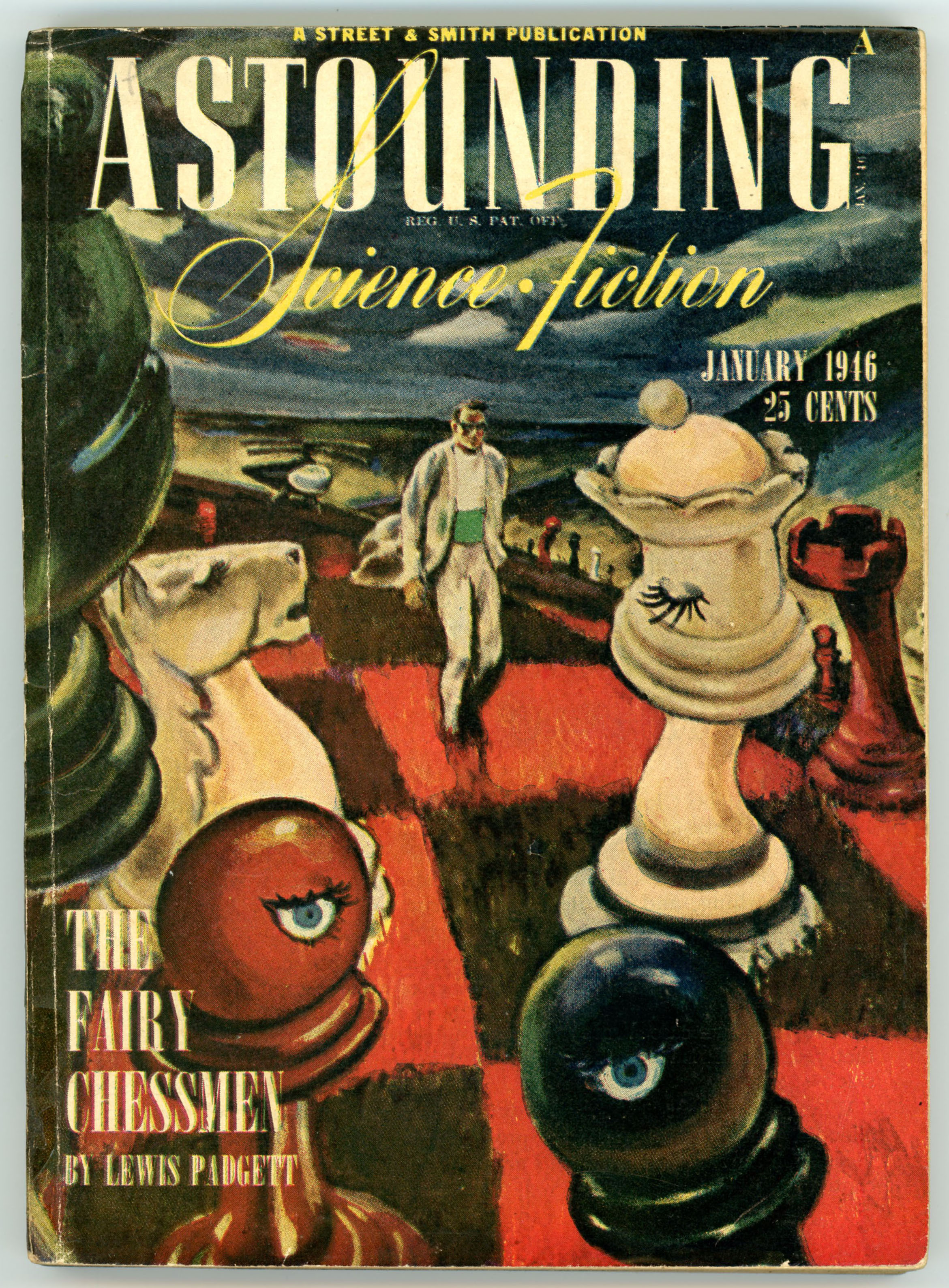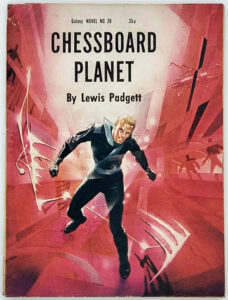Every artist creates works that are memorable. Not necessarily in terms of technical expertise; not in terms of boldness of color; not in terms of clarity and detail. But instead, in terms of qualities that resonate with the human spirit: Ambiguity. Mystery. Symbolism. The unreal, in confrontation with the real.
One such artist was William Timmins, whose cover illustrations were featured on Astounding Science Fiction between December, 1942 and December, 1950. While some of his efforts were – “ho-hum” – adequate if unremarkable, others were striking in their power and boldness, embodying in a single painting a story’s animating concept and message. A particular example is his cover art for the December, 1942 issue of Astounding, for A.E. van Vogt’s “The Weapon Shop”, showing a five-hundred foot high five-tiered information center, from which leads an elevated ramp upon which stand pedestrians. Though a direct representation of a scene central to the story, the image has a dreamlike quality by virtue of the magnitude and distance of the building itself, which is viewed as if from a distance, from a vantage point below the ramp.
An even more memorable painting, for the cover of the January ’46 issue of Astounding, is a representation for Henry Kuttner’s story “The Fairy Chessmen”. (You can access parts one and two via the Pulp Magazine Archive.) In the image, as in the tale, Robert Cameron, civilian director of Psychometrics, is walking across a chessboard-as-hillside-landscape, dominated by human-size pawns, knight, queen, and king. With an autogiro in the distance (they were fashionable in the 40s!), he stands beneath a dark and gloomy sky, with a pattern of square, grayish yellow clouds above.
But, the chessboard is more than a mere chessboard, for the chess pieces are alive, watching, and waiting.
And so, I wondered: “How did Timmins’ painting actually appear, before it was a magazine cover?”
Assuming his painting was lost or destroyed decades ago – like the vast bulk of then unappreciated and now retrospectively invaluable pulp art – I thought I’d do an experiment: Using my scan of the original cover as a basis, I used Photoshop to repair defects, and, create elements of the cover art that were obscured or completely covered by title, logo, and other textual elements. This involved replicating the “fuzziness” and vagueness of some cover features, and at the same time trying to make these modifications consistent with the overall “feel” of Timmins’ painting. While I didn’t do so consciously, on completion, I realized that the square shape of the clouds – with gaps between them – mimicked that of the chessboard.
Perhaps Timmins’ original painting looked something like this.
Hope you like it. Other examples may follow.
The chessmen wonder.
“What is it about SF that draws us?
What is sf anyhow?
It grips fans; it grips editors; it grips writers.
And none make any money.
When I ponder this I see always in my mind
Henry Kuttner’s FAIRY CHESSMEN with its opening paragraph,
the doorknob that winks at the protagonist.
When I ponder this I also see –
outside my mind, right beside my desk –
a complete file of UNKNOWN and UNKNOWN WORLDS,
PLUS Astounding back to October 1933 …
these being guarded by a nine-hundred-pound fireproof file cabinet,
separated from the world,
separated from life.
Hence separated from decay and wear.
Hence separated from time.
I paid $390 for this fireproof file which protects these magazines.
After my wife and daughter these mean more to me than anything else I own –
or hope to own.”
“Notes Made Late at Night by a Weary SF Writer”, by Philip K. Dick
written 1968
in
Eternity Science Fiction, July, 1972
Here’s is Gnome Press’s 1951 edition of Tomorrow and Tomorrow / The Fairy Chessmen, featuring art by Harry Harrison. The dystopian theme of devastation by nuclear war is obviously implied by the presence of a mushroom cloud, a not uncommon visual trope in 50s science fiction art. I had absolutely no idea – until creating this post – that Harrison began his career as an illustrator, his first story appearing in 1951.
Another edition of The Fairy Chessmen, this time published in 1956 as Galaxy (Science Fiction) Novel # 26 under the title Chessboard Planet, with cover illustration by Edmund Emshwiller. The background has somewhat of a Richard Powers-ish feel to it…
(?)
(!)
This Will Read You
Sutin, Lawrence, Divine Invasions – A Life of Philip K. Dick, Harmony Books, New York, N.Y., 1989 (page 35)
11/27/23 – 5




